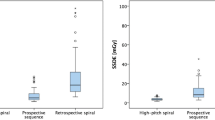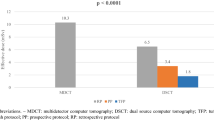Abstract
Objective
Despite attempts to decrease the radiation dose, coronary computed tomography angiography (CCTA) generally uses higher doses than computed tomography scans of other organs. The purpose of this study was to evaluate the incidence of the variations of the coronary arteries using the adaptive statistical iterative reconstruction technique to perform low-dose coronary computed tomography (CTA).
Methods
Diagnostic CCTA scans were performed in 3433 patients (from November 2010 to January 2015) using an Optima CT660 (GE Healthcare, USA) 64-slice and analyzed retrospectively.
Results
The mean effective dose was 2.1 mSv (1.2–4.9 mSv) for prospective and 4.5 mSv (3.6–9.1 mSv) for retrospective ECG-gated scans. The variations of the coronary arteries (CA) excluding myocardial bridge (MB) were detected in 76 (2.2 %) of the 3433 patients. A myocardial bridge was the most common variation (n = 288, 8.3 %). The second most common variation (n = 13, 17.1 %) was an absence of the left main coronary artery (LMCA) with separate starting points for the left anterior descending (LAD) and left circumflex (LCX) arteries. In addition, there was a rare variation (n = 1, 1.3 %) consisting of the LAD artery originating from the right coronary artery (RCA).
Conclusions
The present retrospective study was conducted using CCTA on patients with a coronary artery variations in Turkey (n = 3433). Our data show that low-dose CCTA can be used to detect common coronary variations.
















Similar content being viewed by others
References
Altin C, Kanyilmaz S, Koc S, Gursoy YC, Bal U, Aydinalp A, Yildirir A, Muderrisoglu H (2014) Coronary anatomy, anatomic variations and anomalies: a retrospective coronary angiography study. Singap Med J. doi:10.11622/smedj.2014193. [Epub ahead of print]
Angelini P, Velasco JA, Flamm S (2002) Coronary anomalies: incidence, pathophysiology, and clinical relevance. Circulation 105:2449–2454
Angelini P (2007) Coronary artery anomalies: an entity in search of an identity. Circulation 115:1296–1305
Bozlar U, Ugurel MŞ, Sarı S, Akgun V, Ors F, Tasar M (2015) Prevalence of dual left anterior descending artery variations in CT angiography. Diagn Interv Radiol 21:34–41
Canyigit M, Hazirolan T, Karcaaltincaba M et al (2009) Myocardial bridging as evaluated by 16 row MDCT. Eur J Radiol 69:156–164
Cheitlin MD, De Castro CM, McAllister HA (1974) Sudden death as a complication of anomalous left coronary origin from the anterior sinus of Valsalva A not-so-minor congenital anomaly. Circulation 50:780–787
Eksi Duran N, Aykan AC, Gunduz S, Ozkan M (2010) Single coronary artery in a patient with acute myocardial infarction: atypical connection of left main coronary artery with left coronary system. Anadolu Kardiyol Derg 10:E5–E6
Erol C, Koplay M, Paksoy Y (2013) Evaluation of anatomy, variation and anomalies of the coronary arteries with coronary computed tomography angiography. Anadolu Kardiyol Derg 13:154–164
Greenberg MA (1989) Congenital anomalies of the coronary arteries. Classification and significance. Radiol Clin N Am 27:1127–1146
Hara AK, Paden RG, Silva AC, Kujak JL, Lawder HJ, Pavlicek W (2009) Iterative reconstruction technique for reducing body radiation dose at CT: feasibility study. AJR Am J Roentgenol 193(3):764–771
Harikrishnan S, Jacob SP, Tharakan J et al (2002) Congenital coronary anomalies of origin and distribution in adults: a coronary arteriographic study. Indian Heart J 54:271–275
Hazirolan T, Canyigit M, Karcaaltincaba M et al (2007) Myocardial bridging on MDCT. AJR Am J Roentgenol 188:1074–1080
He G, Liu X, Liu Y, Wang W, Ke Z (2015) Dose study of electrocardiogram automatic tube current modulation technology in prospective coronary computed tomography angiography scans of overweight patients. Exp Ther Med 9(6):2384–2388
Jun BR, Yong HS, Kang EY, Woo OH, Choi EJ (2012) 64-slice coronary computed tomography angiography using low tube voltage of 80 kV in subjects with normal body mass indices: comparative study using 120 kV. Acta Radiol 53(10):1099–1106
Karaosmanoglu D, Karcaaltincaba M, Akata D (2008) Duplicated right coronary artery: multidetector CT angiographic findings. Br J Radiol 81:E215–E217
Koşar P, Ergun E, Ozturk C, Koşar U (2009) Anatomic variations and anomalies of the coronary arteries: 64-slice CT angiographic appearance. Diagn Interv Radiol 15:275–283
Lipton MJ, Barry WH, Obrez I, Silverman JF, Wexler L (1979) Isolated single coronary artery: diagnosis, angiographic classification, and clinical significance. Radiology 130:39–47
Meric M, Soylu K, Gulel O, Zengin H, Demircan S, Yilmaz O, Sahin M (2013) The primary anomalies of coronary artery origin and course: a coronary angiographic analysis of 16,573 patients. Exp Clin Cardiol 18:121–123
O’Leary EL, Garza L, Williams M, McCall D (1998) Images in Cardiovascular Medicine. Vieussens’ Ring. Circulation 98:487–488
Owen AR, Moten SC, Molan MP (2009) Rupture of an aneurysm of vieussens’ arterial ring presenting as acute cardiac tamponade. Clin Radiol 64:1129–1131
Shriki JE, Shinbane JS, Rashid MA, Hindoyan A, Withey JG, DeFrance A et al (2012) Identifying, characterizing, and classifying congenital anomalies of the coronary arteries. Radiographics 32:453–468
Sohrabi B, Habibzadeh A, Abbasov E (2012) The incidence and pattern of coronary artery anomalies in the north-west of Iran: a coronary arteriographic study. Korean Circ J 42:753–760
Spindola-Franco H, Grose R, Solomon N (1983) Dual left anterior descending coronary artery: angiographic description of important variants and surgical implications. Am Heart J 105:445–455
Srinivasan KG, Gaikwad A, Kannan BRJ, Ritesh K, Ushanandini KP (2008) Congenital coronary artery anomalies: diagnosis with 64 slice multidetector row computed tomography coronary angiography: a single-centre study. J Med Imaging Radiat Oncol 52:148–154
Takakuwa KM, Halpern EJ, Gingold EL, Levin DC, Shofer FS (2009) Radiation dose in a “triple rule-out” coronary CT angiography protocol of emergency department patients using 64-MDCT: the impact of ECG-based tube current modulation on age, sex, and body mass index. Am J Roentgenol 192(4):866–872
Taylor AJ, Cerqueira M, Hodgson JM, Mark D, Min J, O’Gara P, Rubin GD (2010) Appropriate use criteria for cardiac computed tomography. J Am Coll Cardiol 56:1864–1894
Turkmen S, Yolcu M, Sertcelik A, Ipek E, Dokumaci B, Foli Batyraliev T (2014) Single coronary artery incidence in 215,140 patients undergoing coronary angiography. Folia Morphol (Warsz) 73:469–474
Yamanaka O, Hobbs RE (1990) Coronary artery anomalies in 126,595 patients undergoing coronary arteriography. Catheter Cardiovasc Diagn 21:28–40
Yoon SR, Jung AY, Choi SH, Bang OY, Lee NH (2010) Anomalous double right coronary arteries: characteristic multidetector-row computed tomography findings. J Comput Assist Tomogr 34:666–669
Yorgun H, Hazırolan T, Kaya EB, Gürses KM, Evranos B, Canpolat U et al (2010) The prevalence of coronary artery anomalies in patients undergoing multidetector computed tomography for the evaluation of coronary artery disease. Turk Kardiyol Dern Ars 38:341–348
Author information
Authors and Affiliations
Corresponding author
Ethics declarations
Conflict of interest
We have no conflicts of interest.
Rights and permissions
About this article
Cite this article
Dogan, N., Dursun, A., Ozkan, H. et al. Low radiation dose computed tomography coronary angiography: evaluation of the variations in coronary arteries. Surg Radiol Anat 38, 1123–1134 (2016). https://doi.org/10.1007/s00276-016-1693-y
Received:
Accepted:
Published:
Issue Date:
DOI: https://doi.org/10.1007/s00276-016-1693-y




